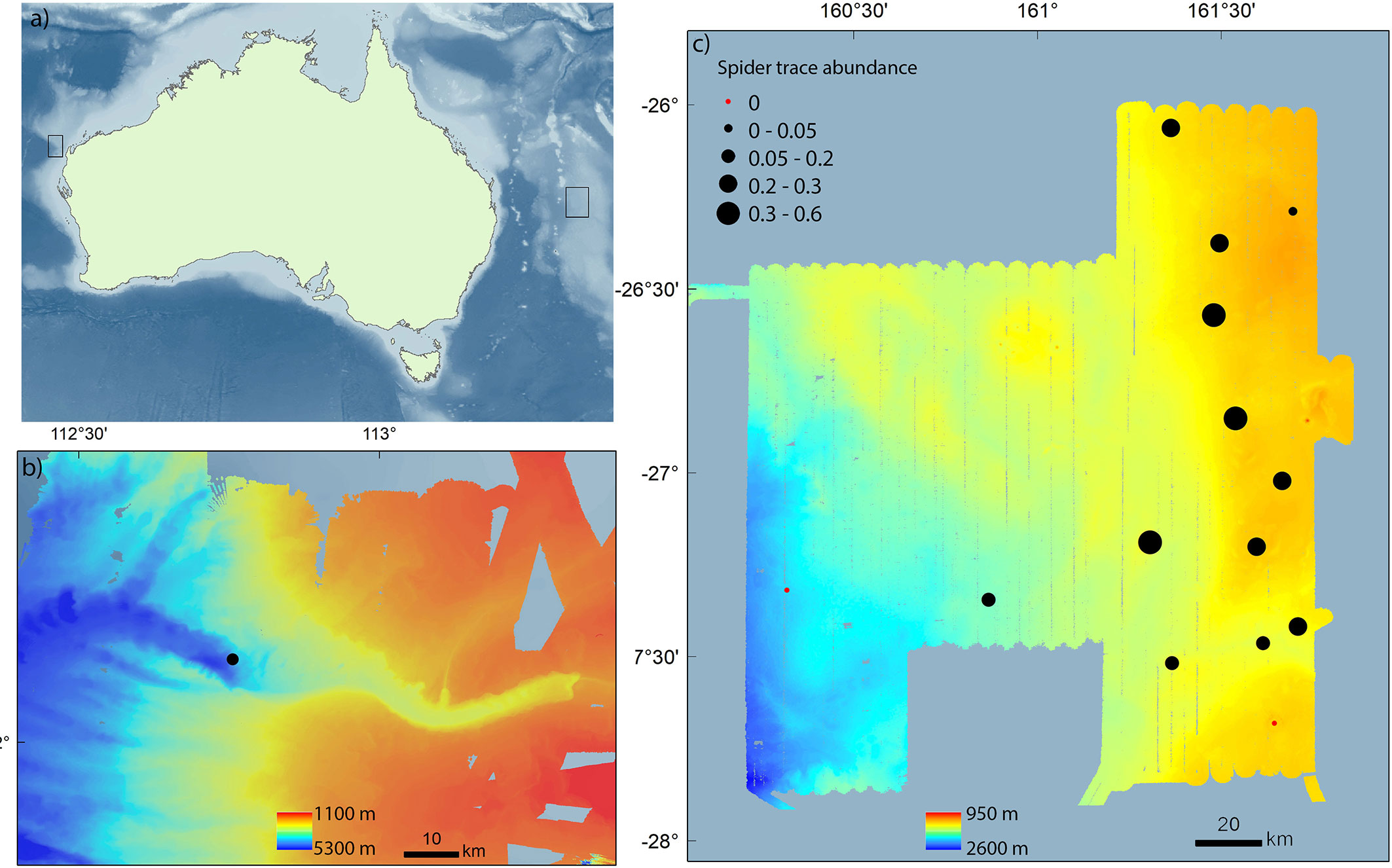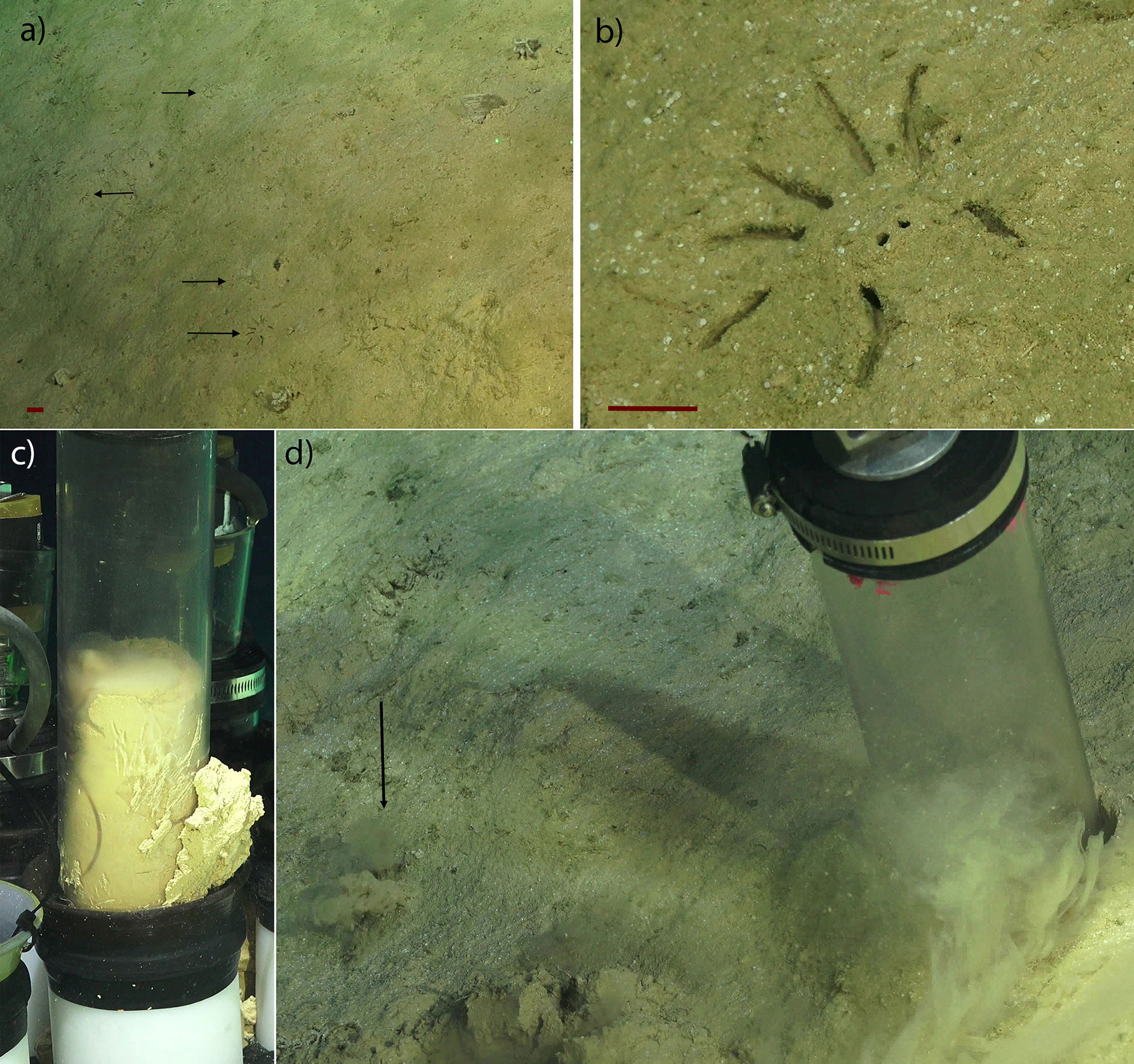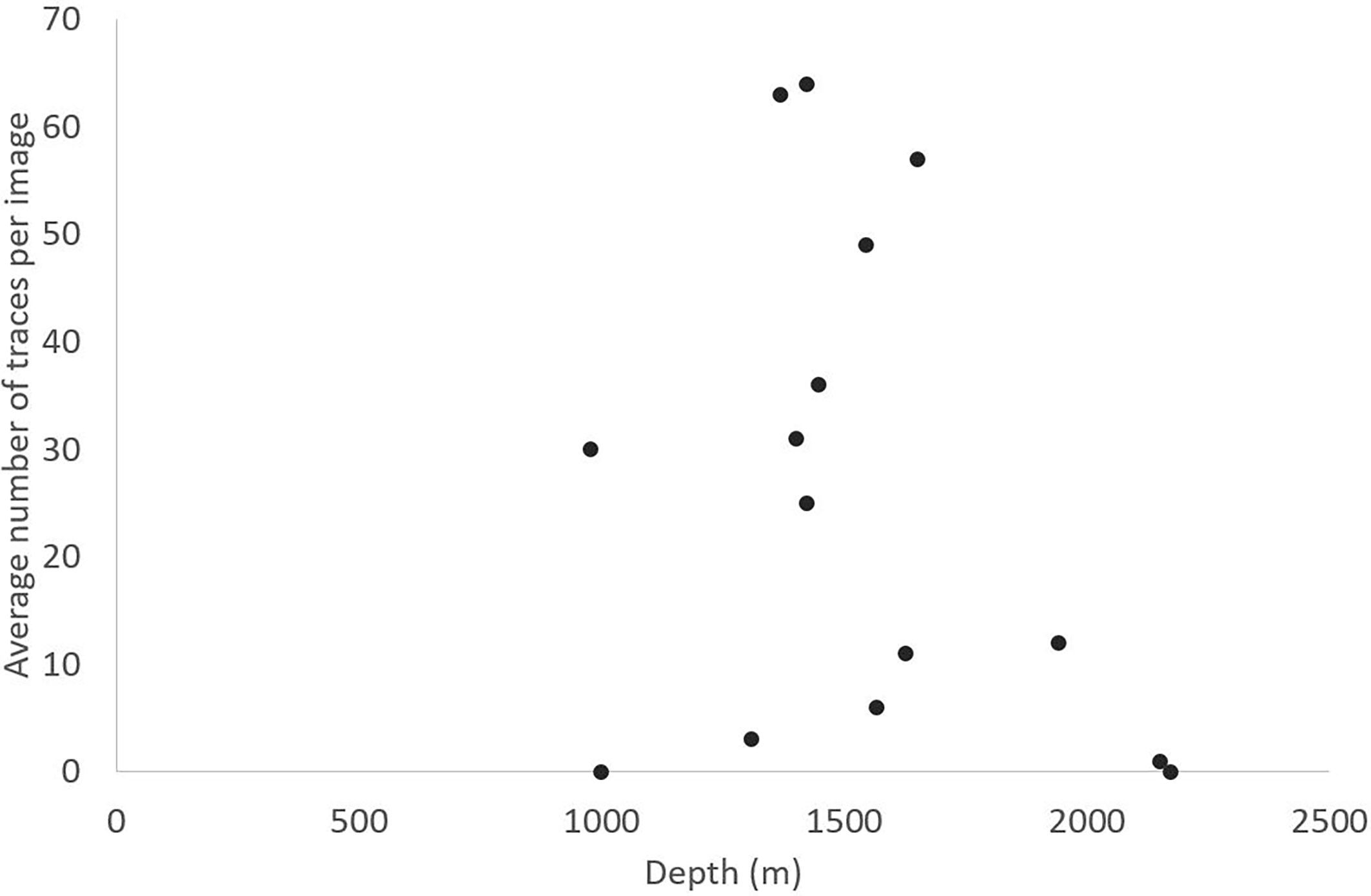- 1New South Wales Department of Primary Industries, Fisheries Research, Huskisson, NSW, Australia
- 2University of Wollongong, School of Earth, Atmospheric and Life Sciences, Wollongong, NSW, Australia
During feeding and burrowing, many epibenthic and infaunal animals bioturbate sediments and form a range of traces called lebensspuren (German for ‘life traces’), defined as any type of sedimentary structure produced by a living organism. During a 2020 survey along western Australia in the Gascoyne Marine Park, a distinct trace was observed several times, identical to the ‘spider trace’ observed in a 2007 survey along eastern Australia, over 4000 km away. The purpose of this brief note is to document and describe the occurrence of this unique and distinctive type of lebensspuren and to discuss ways in which similar observations may be effectively shared to increase our understanding of deep-sea biology.
Introduction
Although our understanding of the deep sea largely remains in the exploratory stage, technological advances have resulted in a surge of deep-sea surveys over the past few decades, often underpinned by high-resolution imagery, targeted sampling collection, and accessible data (Przeslawski and Christenhusz, 2022). These surveys have yielded new species and an improved understanding of deep-sea ecology and anthropogenic impacts, but they have also highlighted knowledge gaps such as those related to lebensspuren (Vecchione and Bergstad, 2022).
During feeding and burrowing, many epibenthic and infaunal animals bioturbate sediments and form a range of traces called lebensspuren (German for ‘life traces’), defined as any type of sedimentary structure produced by a living organism (Ewing and Davis, 1967). Lebensspuren include simple burrows, trails, and mounds, as well as more distinctive traces such spirals and starbursts, some of which are clearly associated with a particular taxon (Anderson et al., 2011). They can be used as a coarse proxy for deep-sea biodiversity and productivity in areas dominated by unconsolidated sediments in which organisms tend to be smaller, infaunal, or less abundant than those from shallower waters or hard substrates (Przeslawski et al., 2012; Miguez-Salas et al., 2020). Due to the low disturbance in many deep-sea environments, these traces can persist for years (e.g. Jamieson et al., 2022).
During a 2020 survey in the Gascoyne Marine Park in western Australia, a distinct trace was observed several times, identical to the ‘spider trace’ observed in a 2007 survey along eastern Australia, over 4000 km away (Przeslawski et al., 2012). The purpose of this brief note is to document and describe the occurrence of this unique and distinctive type of lebensspuren and to discuss ways in which similar observations may be effectively shared to increase our understanding of deep-sea biology.
Methods
Observations were made from imagery acquired from two surveys: 1) a reconnaissance survey led by Geoscience Australia in 2007 to the Lord Howe Rise along the eastern Australian continental margin (TAN0713) and 2) a survey led by the Western Australian Museum in 2020 to the Cape Range and Cloates canyons along the western Australian continental margin (Figure 1).

Figure 1 Location and abundances of spider traces observed along (A) the Australian margin, including from (B) high-resolution ROV imagery (western margin, presence only) and (C) towed imagery (eastern margin, presence and absence). Spider trace abundance represents the average number of traces observed per image at a given station. Bathymetry from Geoscience Australia’s 250 m grid.
Imagery from the western survey was collected from October to November 2007 using a towed deep-water video system on the R.V. Tangaroa. Still images were acquired at 15-second intervals 1-2 m above the seabed. Images were quantitatively annotated, with a series of constraints placed on the analytical techniques to standardise image analysis among stations (see Dundas and Przeslawski, 2009 for details).
Imagery from the eastern survey was collected in March 2020 using the ROV SuBastien from the R.V. Falkor. The majority of imagery was acquired with exploratory movements (i.e. highly variable altitude and speed). We only observed four ‘spider traces’ described in this study from one exploratory dive (ROV340) in which it was opportunistically detected using the 4K resolution of the ROV. Three pushcores were deployed directly over spider traces at a single site (~3886 m depth) to attempt the collection and characterisation of the organisms that made them.
Results
A very distinctive trace was observed in imagery from both the eastern and western Australian margin surveys. The sedimentary structure was morphologically similar across both locations and included two small circular openings (~3 mm diameter) slightly off centre of a shallow mound of sediment. Radiating out from the mound were 6-8 furrowed lines (~10 mm wide, ~100 mm long, based on three traces observed in western margin) oriented in a distinctive pattern that make the entire structure resemble a stylised spider (Figure 2A, B).

Figure 2 Spider traces observed from the western Australian margin (3886 m depth) with (A) ROV camera zoomed out with horizontal arrows showing spider traces, (B) ROV camera zoomed in, (C) pushcore showing possible tendrils extending into sediment, and (D) deployed pushcore with vertical arrow showing sediment plume. Red scale bars represent 100 mm.
On the eastern margin we were able to quantify abundance and distribution because image annotation was targeted on lebesspuren (Przeslawski et al., 2012). Spider traces were locally abundant (Figure 1B), and multiple spider traces were often observed in single images, up to 8 traces in a single image at Station 21 (transect start: 161.480117, -26.572017). The trace was recorded from depths 977-2150 m (Figure 3), representative of the depth range over which the camera was deployed. There is some indication that traces on the eastern margin are more abundant at intermediate depths (Figure 3), but sample sizes were too low to empirically test this. This is likely due to other environmental factors than depth since the western margin traces were found at 3886 m depth.

Figure 3 The relationship between depth and spider traces from the Eastern margin. Each dot represents a towed video transect, and only those transects from which >50 still images were acquired were included. Two transects had no spider traces observed.
The three pushcores collected over the spider traces in the western margin revealed possible tendrils extending beneath the sediment immediately after collection (Figure 2C). In several deployments, sediment plumes were expelled >10 cm from the trace when the tube was pushed into the sediment (Figure 2D), suggesting a possible interconnected network of tunnels beneath the surface. Unfortunately, only one core was intact upon retrieval at the survey, and when this was examined there were no obvious organisms. The sediment was foraminiferal ooze typical of deep-sea plains, with no hard structures or detectable burrows beneath the surface.
Discussion
Observations such as those described here highlight the limited understanding we have of deep-sea biology, particularly for infauna. Many deep-sea investigations rely on imagery which has advanced by leaps and bounds in recent years (Durden et al., 2016). Nevertheless, deep-sea imagery rarely allows for the detection of infauna (but see Mizuno et al., 2022), and we are instead reliant on direct surface detections of infauna during reproduction or feeding (Ohta, 1984), or indirectly via lebensspuren.
To further complicate matters, lebensspuren are commonly preserved as trace fossils, which are then named according to their unique shapes or perceived origin, with no relationship to the actual organism that made them (Gingras et al., 2008). Notably, I have been unable to find any record of a trace fossil resembling the spider trace, suggesting that it is either not conducive to fossilisation or that the organism forming it may be evolutionarily recent or adopting a recent behaviour.
The spider trace is almost certainly biogenic, but its origin remains a mystery. Based on inferences and observations from other lebensspuren (see catalogues in Przeslawski et al., 2012; Bell et al., 2013), the spider trace may represent two burrow entries on a small mound raised from sub-surface biogenic activity, surrounded by radiating feeding explorations. Based on its occurrence along continental margins separated by thousands of kilometres, it is highly likely that the spider trace occurs elsewhere, and it may be that unpublished images have been collected showing the organisms responsible for it. However, without a central repository for lebensspuren occurrences and, more importantly, images capturing their origin, these are not accessible or discoverable. Existing platforms such as iNaturalist or the Ocean Biodiversity Information System (OBIS) may offer a relatively easy way to do this with a designated group for lebensspuren images, but community participation and expert involvement will be essential. In addition, it would be useful to have an endorsed standardised list of lebensspuren types to include in imagery annotation schemes. An Australian imagery annotation system (CATAMI, Althaus et al., 2015) includes lebensspuren as identified in (Przeslawski et al., 2012) and has been successfully applied to several studies (Bell et al., 2013; Beaman et al., 2016; Durden et al., 2020), but this scheme is not global or comprehensive in relation to lebensspuren.
Data availability statement
The imagery presented in this study can be found in the online repository Australian Marine Video and Imagery Collection: https://dap.nci.org.au/thredds/remoteCatalogService?catalog=http://dapds00.nci.org.au/thredds/catalog/fk1/GA4859_CapeRange_FK200308/catalog.xml.
Author contributions
RP undertook the observations and analyses and wrote the paper. The author confirms being the sole contributor of this work and has approved it for publication.
Acknowledgments
Kate Dundas annotated the many images from TAN0713. I’m grateful to the crew of the R.V. Falkor, particularly Jason Rodriguez and the other ROV pilots, as well as the expedition leaders Nerida Wilson and Lisa Kirkendale. Thanks to Mike Vecchione, Jennifer Durden and Rob Beaman for helpful discussions about lebensspuren and to Victoria Cole for reviewing a draft of this note. This work was undertaken for the Marine Biodiversity Hub, a collaborative partnership supported through funding from the Australian Government’s National Environmental Science Program.
Conflict of interest
The authors declares that the research was conducted in the absence of any commercial or financial relationships that could be construed as a potential conflict of interest.
Publisher’s note
All claims expressed in this article are solely those of the authors and do not necessarily represent those of their affiliated organizations, or those of the publisher, the editors and the reviewers. Any product that may be evaluated in this article, or claim that may be made by its manufacturer, is not guaranteed or endorsed by the publisher.
References
Althaus F., Hill N., Ferrari R., Edwards L., Przeslawski R., Schönberg C. H. L., et al. (2015). A standardised vocabulary for identifying benthic biota and substrata from underwater imagery: The CATAMI classification scheme. PloS One 10, e0141039. doi: 10.1371/journal.pone.0141039
Anderson T. J., Przeslawski R., Tran M. (2011). Distribution, abundance and trail characteristics of acorn worms at Australian continental margins. Deep Sea Res. Part II: Topical Stud. Oceanogr 58, 970–978. doi: 10.1016/j.dsr2.2010.10.052
Beaman R. J., Bridge T. C. L., Lüter C., Reitner J., Wörheide G. (2016). Spatial patterns in the distribution of benthic assemblages across a large depth gradient in the coral Sea, Australia. Mar. Biodiversity 46, 795–808. doi: 10.1007/s12526-015-0434-5
Bell J. B., Jones D. O. B., Alt C. H. S. (2013). Lebensspuren of the bathyal mid-Atlantic ridge. Deep Sea Res. Part II: Topical Stud. Oceanogr. 98, 341–351. doi: 10.1016/j.dsr2.2012.09.004
Dundas K., Przeslawski R. (2009). Deep Sea lebensspuren: Biological features on the seafloor of the Eastern and Western Australian margin (Canberra: Geoscience Australia).
Durden J. M., Bett B. J., Huffard C. L., Pebody C., Ruhl H. A., Smith K. L. (2020). Response of deep-sea deposit-feeders to detrital inputs: A comparison of two abyssal time-series sites. Deep Sea Res. Part II: Topical Stud. Oceanogr. 173, 104677. doi: 10.1016/j.dsr2.2019.104677
Durden J. M., Schoening T., Althaus F., Al. E. (2016). Perspectives in visual imaging for marine biology and ecology: From acquisition to understanding. Oceanogr Mar. Biology: Annu. Rev. 54, 1–72. doi: 10.1201/9781315368597-2
Ewing M., Davis R. A. (1967). “Lebensspuren photographed on the ocean floor,” in Deep-Sea photography. Ed. HERSEY J. B. (Baltimore: John Hopkins Press).
Gingras M. K., Dashtgard S. E., Maceachern J. A., Pemberton S. G. (2008). Biology of shallow marine ichnology: A modern perspective. Aquat. Biol. 2, 255–268. doi: 10.3354/ab00055
Jamieson A. J., Bond T., Vescovo V. (2022). No recovery of a large-scale anthropogenic sediment disturbance on the pacific seafloor after 77 years at 6460 m depth. Mar. pollut. Bull. 175, 113374. doi: 10.1016/j.marpolbul.2022.113374
Miguez-Salas O., Huffard C. L., Smith K. L., Mcgill P. R., Rodríguez-Tovar F. J. (2020). Faunal assemblage changes, bioturbation and benthic storms at an abyssal station in the northeastern pacific. Deep Sea Res. Part I: Oceanogr. Res. Papers 160, 103277.10.1016/j.dsr.2020.103277
Mizuno K., Nomaki H., Chen C., Seike K. (2022). Deep-sea infauna with calcified exoskeletons imaged in situ using a new 3D acoustic coring system (A-core-2000). Sci. Rep. 12, 12101. doi: 10.1038/s41598-022-16356-3
Ohta S. (1984). Star-shaped feeding traces produced by echiuran worms on the deep-sea floor of the bay of Bengal. Deep Sea Res. Part A. Oceanogr. Res. Papers 31, 1415–1432. doi: 10.1016/0198-0149(84)90080-3
Przeslawski R., Christenhusz M. J. M. (2022). Deep-sea discoveries. Zoological J. Linn. Soc. 194, 1037–1043. doi: 10.1093/zoolinnean/zlac022
Przeslawski R., Dundas K., Radke L., Anderson T. J. (2012). Deep-sea lebensspuren of the Australian continental margins. Deep Sea Res. Part I: Oceanographic Res. Papers 65, 26–35. doi: 10.1016/j.dsr.2012.03.006
Keywords: ichnology, trace fossils, ROV, deep-sea, underwater imagery
Citation: Przeslawski R (2022) Broad distribution of spider-shaped lebensspuren along the Australian continental margin. Front. Mar. Sci. 9:1086193. doi: 10.3389/fmars.2022.1086193
Received: 01 November 2022; Accepted: 25 November 2022;
Published: 15 December 2022.
Edited by:
Stefanie Kaiser, Senckenberg Research Institute and Natural History Museum Frankfurt, GermanyReviewed by:
Autun Purser, Alfred Wegener Institute Helmholtz Centre for Polar and Marine Research (AWI), GermanyOlmo Miguez-Salas, Senckenberg Nature Research Society, Germany
Michael Vecchione, National Oceanic and Atmospheric Administration (NOAA), United States
Copyright © 2022 Przeslawski. This is an open-access article distributed under the terms of the Creative Commons Attribution License (CC BY). The use, distribution or reproduction in other forums is permitted, provided the original author(s) and the copyright owner(s) are credited and that the original publication in this journal is cited, in accordance with accepted academic practice. No use, distribution or reproduction is permitted which does not comply with these terms.
*Correspondence: Rachel Przeslawski, UmFjaGVsLnByemVzbGF3c2tpQGRwaS5uc3cuZ292LmF1
 Rachel Przeslawski
Rachel Przeslawski